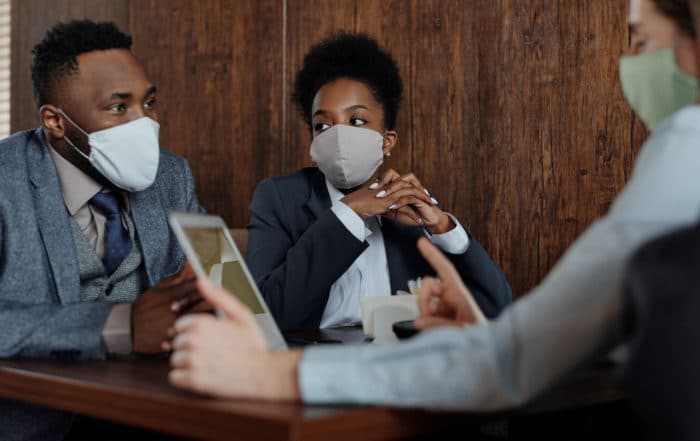Coronavirus Prevention – Improving Air Quality to Get a Building Ready for Work
July 21, 2020 / 10 mins read

After the crisis of COVID-19 has subsided, building owners will need to prep their structures to get ready for work. The outbreak has changed how HVAC professionals view building air circulation and ventilation. Currently implemented HVAC solutions will require some degree of change to function within the new recommendations provided by ASHRAE. These recommendations suggest the type of filters that buildings should use to ensure a safe environment is maintained for all residents.
The ASHRAE recommendations uses the OSHA guidelines regarding preparing workplaces during the COVID-19 outbreak. These recommendations aim to ensure that the building limits the exposure to the virus as much as possible. The hope is that these measures will stem the spread of the disease. In this article, we intend to focus on why building air quality matters in commercial and industrial settings, and how buildings can be adapted to function under the new post-COVID-19 paradigm.
HVAC and Well-Being of Personnel
HVAC has traditionally been the front line of defense against poor air quality. In an enclosed area such as a building, it’s understood that people won’t be able to get much sunlight or fresh air. If a building’s HVAC system isn’t working up to par, it could cause severe problems for those who spend their time within the structure. The Indian Journal of Occupational and Environmental Medicine has termed the disease that arises from this poor circulation as Sick Building Syndrome (SBS).
Sick Building Syndrome
The essence of SBS is people who spend a lot of time within a building get sick because of their presence there. Within the building, symptoms occur, including irritation, nosebleeds, coughing, sneezing, and other allergen-related responses. Outside of the building, these symptoms dissipate. The sources responsible for SBS are hard to pinpoint since the syndrome may be due to several factors. Unfortunately, bacteria aren’t the sole problem here. SBS can also result from volatile organic compounds (VOCs) that exist in most modern building materials such as paint or flooring materials.
Long-Term Illnesses
SBS is a short-term problem, but the longer people work within a building with poor air quality, the more susceptible they become to long-term illnesses. An example of this situation arising is when cooling towers become infected with the bacterium Legionella. Long-term exposure to the bacteria can lead to people who spend a lot of time within the building contracting Legionnaire’s Disease or Pontiac Fever.
Existing filtration systems can deal with these problems, but COVID-19 is an entirely different issue altogether. The virus is far smaller than the previous standards put forth for filters. As a result, the new regulations imposed by ASHRAE suggest that buildings look at improving their filtration systems.
Improving Building Air Quality
Most professionals already know that MERV ratings reflect how effectively filters trap minute particles in the air. Currently, many buildings have opted for MERV-8 filtration because of its cost-effectiveness. According to the National Air Filtration Association (NAFA), systems that aim to remove particles at the scale of 10 micrometers and below (PM10) require a minimum filter rating of MERV 6. Unfortunately, the COVID-19 virus is far smaller than this, and upgrades to MERV filters are the first place for a building to look when aiming to get ready for work.
Upgrading MERV Filters
As a business owner, it may be difficult to fathom how to upgrade the HVAC system of a building for coronavirus prevention while still ensuring that the building falls within acceptable performance parameters. However, there are some practical steps that an owner can take to perform this upgrade:
- Hire on (or contract) a qualified design professional, certified testing, adjusting, and balancing (TAB) service provider, or an accredited commissioning provider (CxP) if your HVAC system is extensive or complicated.
- Consult the documentation for your filters. If a TAB agent was previously used in the HVAC installation, then the report they produced would be an excellent location to start. Comparing the original TAB report to the latest filter information can give an idea of how building use has changed over time and how the HVAC system has been adapted to the new usage.
- Examine existing filter documentation for size details and thickness of the filters currently installed. Consult the manufacturer’s website to ascertain the details of the filters.
- Inspect filter frames for a nice, tight fit. If spaces exist, then introducing a silicone-based sealant to create an airtight seal is recommended. This adjustment should happen both upstream and downstream of the filter.
- Before installing the new filters, the TAB should perform a complete static pressure and temperature profile. If the filters are dirty, return them to their locations and have the TAB perform the profiling, then change the dirty filters out for clean ones, and redo the profile. The TAB production document should outline changes in fan RPM, voltages from the power supply, and amperage draw at each location.
- Determine what the “dirty” filter setpoint is and have the TAB agent insert blockages to attain that filter setpoint. Using this data, the TAB agent can then move to develop a new unit profile.
- The TAB agent can calculate acceptable airflow parameters in combination with the new MERV filters. Once the filters are installed, the TAB agent can then calculate percentages in airflow to ensure that the system operates within acceptable limits and doesn’t fall prey to coil freezing or suction pressure issues.
- If further design changes are needed to support a higher MERV rating, you may be required to hire a design professional to size and choose new fan units and filters for the system.
- If the existing system can handle an increase in the MERV level, then in areas that have high occupancy, building owners can invest in portable HEPA filter units to aid in increasing the air quality.
ASHRAE has stated that buildings should be looking at a minimum rating of MERV 13 for their filters if they intend to open during the coronavirus epidemic. The suggestion takes into account that a MERV 13 filter removes more than 50% of the particles in the air that fall between 0.3 and 1.0 microns in diameter.
How Cleaner Air Impacts the Bottom Line
Cleaner air has other benefits, aside from controlling the spread of a deadly virus. Business owners should be aware that increasing their air filtration levels will result in some other consequences, including:
- Improve Operating Efficiency: Businesses that have clean air filtration systems spend less on heating and cooling bills. Dirty filters provide resistance to airflow and, as a result, require the use of fans more often to maintain airflow values. Cleaner filters make for more efficient use of energy to power fans within the system.
- Safer Working Conditions: COVID-19 is only the most recent variety of a series of airborne flu-like diseases. Seasonal cases of flu are also an issue in enclosed buildings. Proper air cleaning procedures with filters that surpass the minimum rating make for a lower spread of pathogens across the building’s environment. New recommendations regarding the mixture of recycled and fresh air in HVAC systems further help to control the spread of airborne pathogens.
- Higher Rent Justification: Business owners that provide rentals can get a bit more in rent if they can show that their airflow system provides cleaner air than other properties. Better filters and a more efficient system design can help with justifying a higher rental price.
HVAC’s Role in Returning to Work
The logical supposition that led to the shelter-in-place orders in most states came from an understanding that community spread of the diseases is higher in enclosed spaces. Buildings are one such space. Companies that want to get ready for work while maintaining their readiness for coronavirus prevention need to look at practical ways of increasing the quality of their air filtration systems. These tips should help you to develop a road map towards the practical implementation of a new HVAC system or to upgrade the one that your building currently has in place.
Be sure to check out our Portable Air Purifier calculator to assist you in identifying how to select the appropriate air purifier for any smaller rooms in your facility.
Need help with your project? Let’s get in touch!
Lorem ipsum dolor sit amet, consectetuer adipiscing elit.


